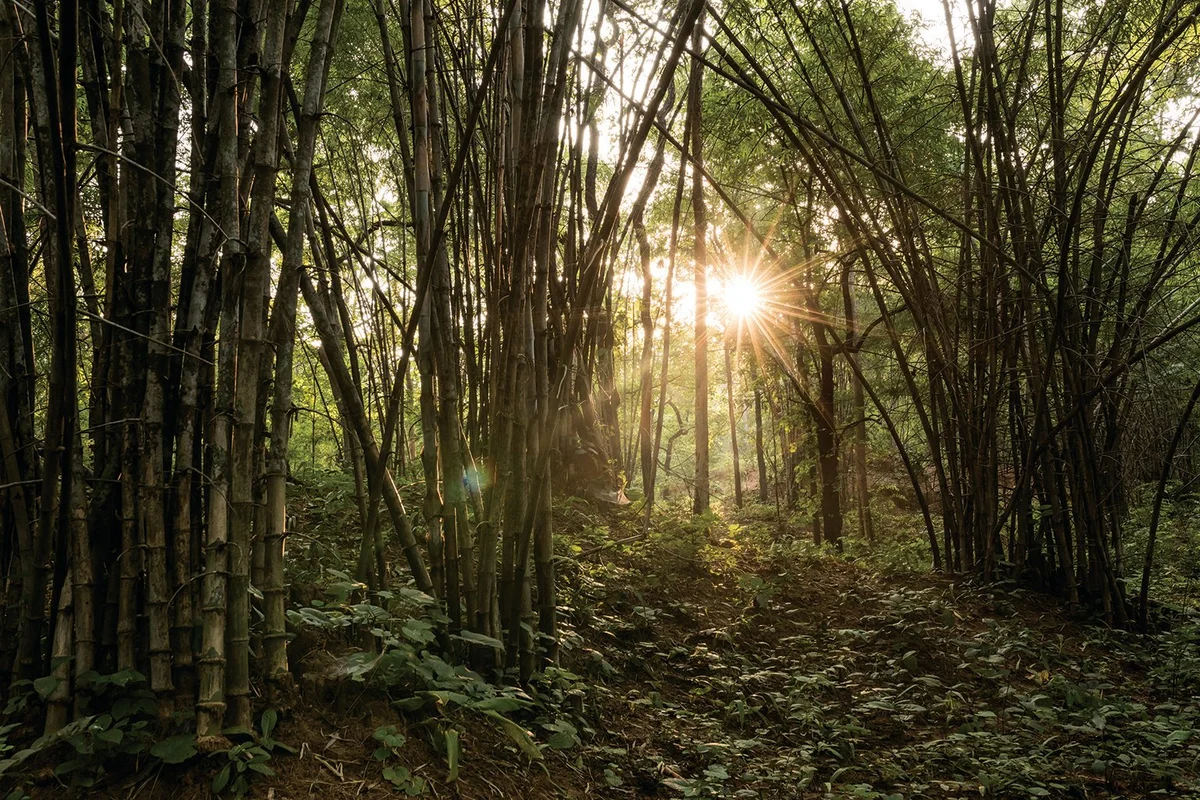Share this Article
Introduction: Nature, Spirituality, and Conservation
In many parts of Nepal, the bond between people and nature has always been more than ecological—it is spiritual. Forests, rivers, and mountains are not merely natural resources; they are sacred entities tied to gods, spirits, and ancestral traditions. Among these sacred natural sites, sacred groves hold a unique place in the cultural and ecological fabric of Nepal. These groves—patches of forest protected by local communities for religious or spiritual reasons—are found in various regions across the country, including the Chitwan Hills, where they form a remarkable blend of cultural reverence and biological richness.
The sacred groves of Chitwan are more than religious sanctuaries; they are living museums of biodiversity, sheltering countless species of flora and fauna. At a time when rapid urbanization, deforestation, and agricultural expansion threaten natural ecosystems, these groves serve as pockets of preserved wilderness, maintained through centuries of cultural respect rather than formal conservation policies. They demonstrate how traditional beliefs and indigenous practices can coexist with, and even reinforce, modern environmental goals.
Understanding Sacred Groves
Sacred groves are small forest patches conserved for religious, cultural, or spiritual reasons. They are often dedicated to local deities, guardian spirits, or ancestral gods and are protected by unwritten social norms that prohibit activities such as tree cutting, hunting, or land clearing. The belief that disturbing these forests will anger the deities has historically served as a strong deterrent to exploitation. As a result, these groves have remained ecologically intact for generations, serving as refuges for plant and animal species that might otherwise have vanished from surrounding landscapes.
In the Chitwan Hills, sacred groves are locally known by different names—sometimes called ban devi ko ban (forest of the forest goddess) or than (sacred place). They vary in size, from small clusters of trees surrounding shrines to larger tracts extending across several hectares. What makes them significant is that they are not protected by law but by culture—a testament to the enduring power of faith-based conservation.
Cultural Significance in the Chitwan Region
The Chitwan Hills are home to a diverse mix of ethnic and indigenous groups, including the Tharu, Gurung, Magar, and Chepang communities. Each group has its own set of beliefs and rituals tied to the natural environment. For the Tharu people, nature is inhabited by spirits that protect the village and its people. Trees such as the peepal (Ficus religiosa), banyan (Ficus benghalensis), and sal (Shorea robusta) are regarded as sacred. Shrines or stone altars are often found under these trees, where offerings are made during local festivals or when seeking blessings for harvests, rainfall, or health.
In many Tharu villages of the Chitwan Hills, sacred groves are linked to deuthan puja or ban devi puja, annual rituals performed to honor forest deities. These events are not merely religious gatherings but also reinforce communal rules that prohibit deforestation and overharvesting. Among the Gurung and Magar communities, similar practices exist, where certain forest patches are reserved for spiritual rituals and community gatherings. The Chepang people, who are known for their deep forest knowledge, often associate sacred groves with ancestral spirits, and entering these areas requires ritual purity and respect.
These traditions reflect a deep ecological wisdom—the understanding that human survival and spiritual well-being depend on the health of the forest.
Ecological Features of the Chitwan Hills
The Chitwan Hills, located in the southern mid-hill region of Nepal, represent a transitional ecological zone between the Terai plains and the high Himalayan foothills. This geographic diversity gives rise to a mosaic of habitats—sal forests, riverine woodlands, grasslands, and patches of mixed hardwood forests. The climate is subtropical, with warm, humid summers and mild winters, creating favorable conditions for rich biological diversity.
Within these landscapes, sacred groves act as microcosms of larger ecosystems. Because they have been shielded from logging and agricultural encroachment, they often contain mature forest structures, old-growth trees, and understory vegetation that is rare in nearby exploited forests. Many groves also serve as water sources, harboring springs and streams that sustain local communities during dry seasons. The microclimatic stability within these groves supports a wide range of species—from lichens and orchids to mammals and birds—making them essential biodiversity reservoirs.
Floral Diversity in Sacred Groves
The sacred groves of the Chitwan Hills are botanical treasure troves. The dominant tree species include Shorea robusta (sal), Terminalia tomentosa (asna), Ficus religiosa (peepal), Ficus benghalensis (banyan), and Syzygium cumini (jamun). These trees are often considered sacred due to their association with Hindu deities or traditional rituals. Beneath the canopy grow shrubs like Clerodendrum viscosum, Woodfordia fruticosa, and Justicia adhatoda, which are valued for their medicinal properties.
In addition to native trees, sacred groves also host climbers, ferns, epiphytes, and grasses, contributing to layered vegetation structures that provide habitat diversity. Orchids, which thrive in the moist microclimates of shaded groves, are particularly abundant. Some groves even harbor rare or endemic plant species that have disappeared from surrounding cleared lands. Because human interference is minimal, these areas serve as natural gene banks that preserve the ecological integrity of the Chitwan Hills.
The local people have deep ethnobotanical knowledge associated with these groves. Medicinal plants found here are used in traditional healing practices to treat ailments such as fever, cough, wounds, and digestive disorders. This relationship between biodiversity and cultural medicine underscores the multifunctional value of sacred forests.
Faunal Diversity in Sacred Groves
The undisturbed environment of sacred groves provides shelter and breeding grounds for a variety of wildlife. Mammals such as monkeys, squirrels, civets, and mongoose are commonly found, while in the larger groves near forested zones, deer and even wild boar may occasionally be seen. Birds are particularly abundant, as groves offer nesting sites, food sources, and safety from human disturbance. Species such as the oriental magpie robin, drongos, barbets, bulbuls, and woodpeckers are frequently observed. The presence of fruit-bearing trees attracts frugivorous birds and bats, which play vital roles in seed dispersal and pollination.
Reptiles and amphibians also find refuge in these moist, shaded habitats. Lizards, snakes, frogs, and toads thrive in the leaf litter and undergrowth. The abundance of insects—especially butterflies and bees—indicates the ecological health of these groves. Together, these faunal components maintain ecosystem balance, contribute to nutrient cycling, and enhance the resilience of local biodiversity.
The Role of Sacred Groves in Ecosystem Services
Sacred groves provide a range of ecosystem services that benefit both nature and people. They regulate water cycles by protecting watersheds and reducing soil erosion. The trees stabilize slopes and maintain groundwater levels, which is crucial in hilly regions like Chitwan. The dense vegetation also acts as a carbon sink, absorbing carbon dioxide and mitigating the impacts of climate change.
In addition to ecological services, sacred groves contribute to human well-being. They provide clean air, serve as places of recreation and spiritual retreat, and preserve traditional knowledge systems. During local festivals, these groves become centers of community gathering and cultural expression. The aesthetic and spiritual value attached to them fosters a sense of environmental stewardship among villagers, ensuring their continued protection.
Traditional Conservation Practices
Unlike government-managed forests, sacred groves are maintained through community-based traditional governance systems. Each community has specific taboos, rituals, and rules that regulate human interaction with the grove. Cutting trees, hunting animals, or grazing cattle within these areas is often forbidden. In some villages, anyone who violates these norms must perform a cleansing ritual or pay a fine to appease the forest deity. These traditional enforcement mechanisms are remarkably effective in maintaining ecological integrity without external intervention.
Seasonal rituals are also central to grove protection. Before harvesting forest products like medicinal herbs or firewood, people often seek permission from the deity. Offerings of flowers, grains, or incense symbolize gratitude and respect. Such practices not only sustain the ecological balance but also strengthen community cohesion. The sacredness of these groves thus acts as a natural law—a form of conservation deeply embedded in cultural ethics.
Threats to Sacred Groves
Despite their spiritual and ecological importance, sacred groves in the Chitwan Hills are under increasing pressure. Population growth and land scarcity have led to encroachment and conversion of forest land into agriculture and settlements. Younger generations, influenced by modern lifestyles and migration, are gradually losing connection with traditional beliefs. As a result, the taboos that once protected these groves are weakening.
Unregulated tourism, infrastructure development, and road expansion have also contributed to the degradation of these sites. In some areas, illegal logging and grazing have reduced canopy cover and disturbed wildlife. Climate change adds another layer of threat, altering rainfall patterns and affecting the delicate balance of forest ecosystems. Without active conservation efforts, these living sanctuaries could be lost—along with the biodiversity and cultural heritage they embody.
Integrating Traditional Knowledge with Modern Conservation
To ensure the survival of sacred groves, it is essential to integrate traditional conservation systems with modern scientific approaches. Local communities possess invaluable knowledge about forest ecology, species behavior, and natural cycles. By recognizing and supporting these indigenous systems, conservation programs can achieve both cultural and ecological goals. Government agencies and NGOs should collaborate with local leaders to map, document, and legally recognize sacred groves as community conservation areas.
Education and awareness campaigns can help revive traditional respect for these sites among younger generations. Sustainable tourism initiatives can also be introduced, allowing visitors to appreciate the cultural and natural significance of the groves while providing income for local communities. Involving schools in grove-related environmental education can foster a sense of pride and responsibility toward these heritage forests.
Scientific research should focus on cataloging the biodiversity of sacred groves, monitoring ecological changes, and assessing their role in climate resilience. Combining traditional ethics with modern environmental management will create a strong foundation for long-term protection.
Sacred Groves as Models for Sustainable Living
The sacred groves of Chitwan offer profound lessons for sustainable living. They demonstrate that ecological conservation does not always require complex regulations or external enforcement; it can emerge naturally from cultural values and community ethics. The reverence for nature inherent in these traditions embodies a worldview where humans are caretakers rather than conquerors of the Earth.
In an era of ecological crises, the sacred grove model represents a sustainable alternative—a system where environmental protection, spirituality, and social harmony coexist. By reviving and respecting these traditions, modern societies can reconnect with the deep ecological consciousness that has sustained communities for centuries.
Conclusion: Preserving Sacred Nature for the Future
The sacred groves of the Chitwan Hills are more than remnants of ancient forests—they are living symbols of harmony between humans and nature. Their trees whisper stories of faith, their streams nourish life, and their soil shelters countless organisms that sustain the local ecosystem. As both cultural heritage and biodiversity hotspots, they hold immense value for Nepal and the world.
Protecting these groves is not merely an act of conservation; it is an act of cultural preservation and spiritual renewal. By blending traditional wisdom with modern science, empowering local communities, and raising awareness about their ecological significance, we can ensure that these sacred landscapes continue to thrive for generations to come. The sacred groves remind us that true conservation begins with reverence—with the understanding that nature, when respected as sacred, gives back in abundance.
Categories:
Nature & Wildlife
Tags:
SacredGroves
,
ChitwanHills
,
BiodiversityConservation
,
EcologicalHeritage







